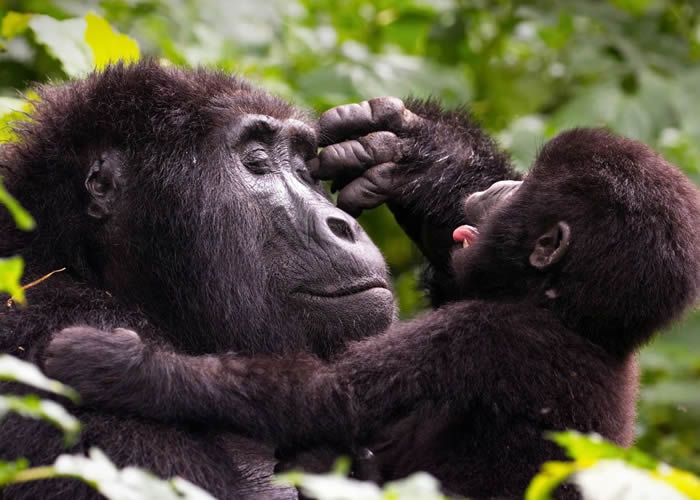Gorilla trekking in Uganda is one of the most exhilarating wildlife experiences on the planet, offering an up-close encounter with the majestic and endangered mountain gorillas. Nestled in the southwestern part of the country, Bwindi Impenetrable Forest National Park and Mgahinga Gorilla National Park are the two premier destinations where visitors can track these remarkable creatures in their natural habitat. This once-in-a-lifetime adventure not only offers a thrilling wildlife experience but also contributes to the conservation of these endangered animals and the communities that surround the parks.
Bwindi Impenetrable Forest National Park
Bwindi is the most renowned destination for gorilla trekking in Uganda and is home to almost half of the world’s population of mountain gorillas. The park is a UNESCO World Heritage Site, famous for its dense, mist-covered rainforest that provides a lush and dramatic backdrop for tracking gorillas. Covering over 331 square kilometers, the forest is aptly named “impenetrable” due to its thick undergrowth, making it an authentic and rugged jungle experience.
 Gorilla trekking in Bwindi starts early in the morning with a briefing from the Uganda Wildlife Authority (UWA) at one of the four main sectors—Buhoma, Ruhija, Nkuringo, and Rushaga. Each of these sectors is home to several habituated gorilla families, making it possible to track different groups of gorillas across the park. Trekking through the forest can take anywhere from one to six hours, depending on the location of the gorilla family. Once you find them, you are allowed one hour to observe the gorillas as they go about their daily life—feeding, playing, and interacting with each other. This intimate encounter, just meters away from a 400-pound silverback and his family, is both humbling and awe-inspiring.
Gorilla trekking in Bwindi starts early in the morning with a briefing from the Uganda Wildlife Authority (UWA) at one of the four main sectors—Buhoma, Ruhija, Nkuringo, and Rushaga. Each of these sectors is home to several habituated gorilla families, making it possible to track different groups of gorillas across the park. Trekking through the forest can take anywhere from one to six hours, depending on the location of the gorilla family. Once you find them, you are allowed one hour to observe the gorillas as they go about their daily life—feeding, playing, and interacting with each other. This intimate encounter, just meters away from a 400-pound silverback and his family, is both humbling and awe-inspiring.
Beyond gorillas, Bwindi is a biodiversity hotspot. The park is also home to other primates like colobus monkeys and chimpanzees, as well as hundreds of bird species, making it a paradise for nature lovers and birdwatchers alike.
Mgahinga Gorilla National Park
Though smaller than Bwindi, Mgahinga Gorilla National Park offers an equally captivating gorilla trekking experience. Mgahinga is part of the larger Virunga Conservation Area, which extends into Rwanda and the Democratic Republic of Congo. The park’s 33 square kilometers are nestled at the base of the Virunga Mountain ranges, offering stunning volcanic landscapes.
Mgahinga is home to one habituated gorilla family, the Nyakagezi group, which consists of a silverback, females, juveniles, and infants. This gorilla family is known for moving between Uganda, Rwanda, and Congo, but has recently settled in Uganda for consistent trekking opportunities. The park’s unique setting allows for gorilla trekking with panoramic views of the surrounding volcanoes, giving the experience an added touch of adventure.
 Aside from gorilla trekking, Mgahinga offers an opportunity to hike the volcanic mountains of the Virunga Range, including Mount Gahinga, Mount Sabinyo, and Mount Muhabura. Visitors can also engage in golden monkey tracking, another rare primate species found in the park, or explore the Batwa Trail to learn about the indigenous Batwa pygmy culture.
Aside from gorilla trekking, Mgahinga offers an opportunity to hike the volcanic mountains of the Virunga Range, including Mount Gahinga, Mount Sabinyo, and Mount Muhabura. Visitors can also engage in golden monkey tracking, another rare primate species found in the park, or explore the Batwa Trail to learn about the indigenous Batwa pygmy culture.
Why Trek Gorillas in Uganda?
Uganda offers some of the most affordable gorilla trekking permits compared to neighboring Rwanda, making it an accessible option for many travelers. The permits in Uganda cost $700, compared to Rwanda’s $1,500. Additionally, the variety of gorilla families and trekking routes in Bwindi, coupled with the scenic beauty and adventurous terrain of Mgahinga, make Uganda a top choice for those seeking an immersive and authentic gorilla trekking experience.
Practical Information
The best time to visit Bwindi and Mgahinga is during the dry seasons from June to August and December to February, when the forest trails are more accessible. However, trekking is available year-round, and the wet seasons often offer fewer crowds and a lush, vibrant landscape.
Gorilla trekking permits should be booked well in advance due to limited availability. The trek requires a moderate level of fitness, as the terrain can be steep and challenging, but the reward of standing face to face with a mountain gorilla makes every step worth it.

